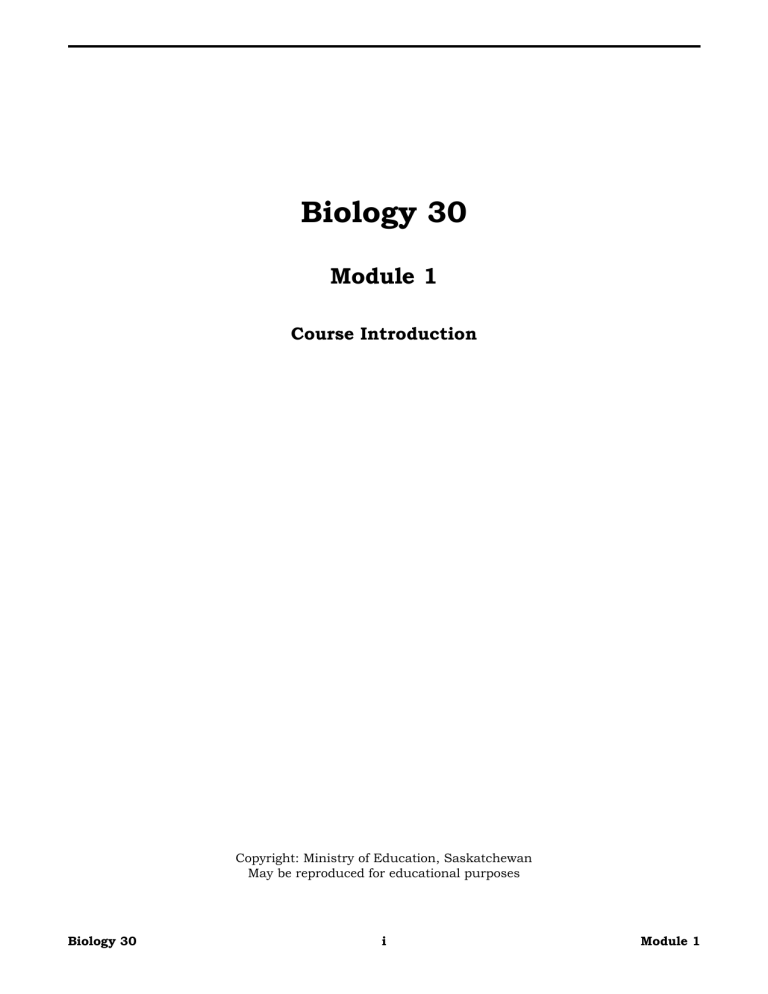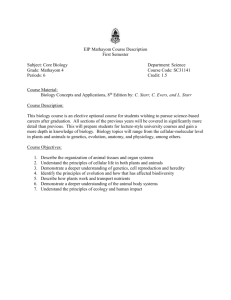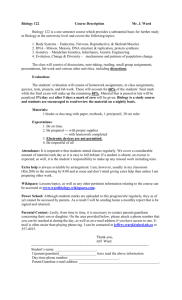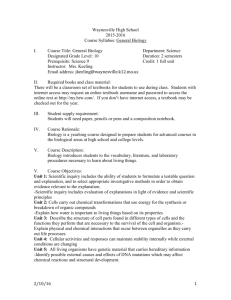Biology 30 Module 1 Course Introduction Copyright: Ministry of

Biology 30
Module 1
Course Introduction
Biology 30
Copyright: Ministry of Education, Saskatchewan
May be reproduced for educational purposes i Module 1
Biology 30 ii Module 1
Introduction
Welcome to Biology 30!
You are about to embark on an incredible journey! Regardless of the reason that you are taking this course (mostly for credit I’m sure!), we hope that a spark is ignited for the
“study of life” in general. You may even find a specific area of study that you may want to focus in on for your life’s work.
Biology 30 provides an exciting exploration of the study of life.
The course begins by examining some life-sustaining actions carried out by cells.
Characteristics and actions that are applicable to many kinds of cells are looked at.
Some of the topics covered are osmosis, diffusion, mitosis, photosynthesis, cellular respiration.
Body systems are of great interest. Several of the body systems are covered by tracing their development from the "simple" to the more complex organisms, with greater emphasis on humans.
The course continues by examining reproduction and the transmission of genetic traits or characteristics of parent organisms to their offspring.
Even though cell reproduction is an important process occurring in individual multicellular organisms, reproduction on a larger scale is essential for the continued survival of individual species. Reproduction, by itself, does not ensure the survival of any particular species. Many species have become extinct and those that continue to survive often experience changes in body structures, body biochemistries, behaviours and other characteristics. Such organic variations or evolutions will form the concluding part of the course.
Enjoy your voyage!
Biology 30 iii Module 1
References
A text book is not required to take this course. However, it is always good to have a reference text available to provide additional information. For example, another source may explain a topic just a little differently, or there may be diagrams or charts that may be of assistance.
Suggested Texts
Biological Science: An Ecological Approach: BSCS Green Version. Kendall/Hunt
Publishing. (7 th or 8 th edition)
Biology, (1993). Nelson Thomson Learning, Scarborough, ON
There are various other authorized textbooks that can provide the student with additional information on topics covered in this course.
Biology 30 iv Module 1
Organization of the Course
This course is organized in modular format where each module includes information related to a certain group of ideas. You should not take these groupings to mean that the information contained in each module is completely different from that in the others. On the contrary, many ideas or concepts occur over and over again throughout the course and even extend into other subject areas. The setting up and allocating of the material into various modules is intended to make the presentation and study of this course as effective as possible.
There will be four modules in all, with varying numbers of lessons. The lengths of the lessons and modules will depend on the amount and complexity of the material to be covered.
Module 1: Cells and Biochemical Actions: Foundations of Life.
Lessons 1 – 4
Module 2: Body Actions and Systems: Maintaining Life.
Lessons 5 – 9
Module 3: Reproduction and Genetics.
Lessons 10 – 13
Module 4: Organic Variation.
Lessons 14 - 16
Biology 30 v Module 1
Method of Study
Each individual generally develops his/her own method of study. Check out the following suggestions that you can follow or modify to suit yourself.
When you receive the modules, place the course pages in a three-ring binder. This should make the handling of the modules easier and more orderly, with less chance of losing pages.
At the beginning of each module is a table of contents for the lessons that it contains. When you begin a lesson:
check the contents for that particular lesson to obtain some idea of the material that it covers.
Read over the objectives listed at the beginning of the lesson.
Quickly read or skim through the contents of the lesson and possibly the questions of the assignment which follows.
Following this first quick reading, begin going through the course material in more detail – making notes in a separate notebook, if you wish.
At this time, you may want to use the table of contents or the index of a reference text to locate material to add to the information or to try and better your understanding on some topic or concept.
Once the reading has been done, begin the assignment. Do not hesitate in reviewing course material or in seeking out information from other references when working on the individual questions or tasks.
Some of the questions are factual-knowledge based.
Some questions are synthesis–type, where a student has to bring different pieces of information together to answer the question. Thought and consideration are necessary.
Some questions are application to real life situations. In light of the facts and information learned in the course the student will attempt to explain what is happening in an outlined situation.
After completing a lesson, review the objectives listed at the beginning of the lesson you have just worked on in order to obtain some idea of how close you have come to achieving them.
Biology 30 vi Module 1
General Pointers on Assignments
1. Do multiple choice questions right on the sheets given in the assignments.
Check off your choice of answer.
2. Do all questions. Do not submit an assignment that is half done. If there is a question that you are having difficult with – this is the time that you contact your teacher for help.
3. Your work should be original (your own).
4. Submit assignments, regularly.
Biology 30 vii Module 1
Course Outline
Module 1 Cells and Biochemical Actions: Foundations of Life
Lesson 1 The Cell
Lesson 2 Cell Physiology: Homeostasis
Lesson 3 Cell Physiology: A Chemical Background
Lesson 4 Food and Energy: A Closer Look
Module 2 Body Actions and Systems: Maintaining Life
Lesson 5 Body (Cell) Requirements
Lesson 6 Body (Cell) Wastes
Lesson 7 Transport Systems
Lesson 8 Nervous and Sensory Systems
Lesson 9 Chemical Control and Coordination
Module 3 Reproduction and Genetics
Lesson 10 Types of Reproduction
Lesson 11 Types of Reproduction and Development: Single Organisms to Vertebrates
Lesson 12 Heredity and Genetics
Lesson 13 Chromosomes and Genetics
Module 4 Organic Variation
Lesson 14 Organic Variations: Evidences of Change
Lesson 15 Forces Acting on Populations: Stabilizing and De-stabilizing
Lesson 16 Sample examination
Biology 30 viii Module 1







